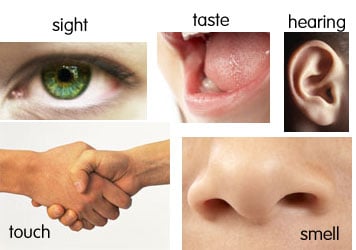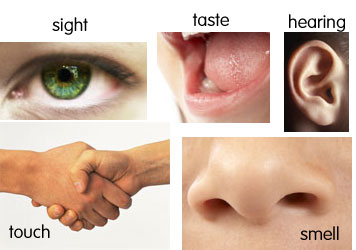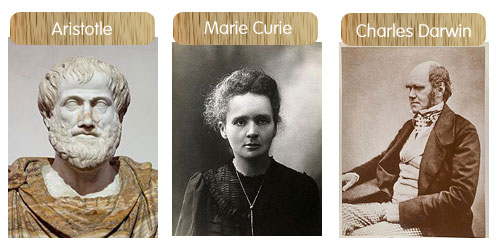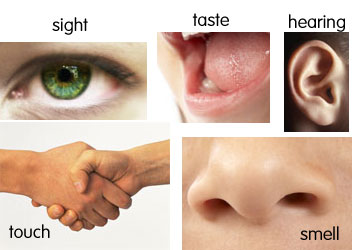Brainiac: K: Science: Quiz 1

Choose the correct answer to the questions about the 5 senses.
Resource for finding the answers: www. Wikipedia. Org/wiki/senses
- 1.
How many senses are there in this picture?
- A.
4
- B.
5
- C.
6
Correct Answer
B. 5Explanation
The picture likely contains five senses because humans typically have five senses: sight, hearing, taste, smell, and touch. These senses allow us to perceive and interact with the world around us. Therefore, it is reasonable to assume that the picture represents these five senses.Rate this question:
-
- 2.
Which of the 3 scientists shown above is the one responsible for the classification of the 5 senses?
- A.
Aristotle
- B.
Marie Curie
- C.
Charles Darwin
Correct Answer
A. AristotleExplanation
Aristotle is the correct answer because he is the scientist responsible for the classification of the 5 senses. He was a Greek philosopher and scientist who categorized the senses into touch, taste, smell, sight, and hearing. Aristotle's work on the senses laid the foundation for our understanding of sensory perception and has had a significant impact on the field of psychology and neuroscience.Rate this question:
-
- 3.
Which sense describes the brain’s ability to detect light, color, and depth?
- A.
Sight
- B.
Smell
- C.
Touch
Correct Answer
A. SightExplanation
Sight is the sense that describes the brain's ability to detect light, color, and depth. Through the eyes, the brain receives visual information and processes it to form images, allowing us to perceive the world around us. This sense is responsible for our ability to see objects, distinguish colors, and perceive depth and distance. Smell and touch, on the other hand, are senses that involve different sensory organs and serve different purposes.Rate this question:
-
- 4.
What word means "the inability to see?"
- A.
Deaf
- B.
Blind
Correct Answer
B. BlindExplanation
Blind is the correct answer because it refers to the condition of being unable to see. Deaf, on the other hand, refers to the inability to hear. Therefore, blind is the word that specifically means "the inability to see."Rate this question:
-
- 5.
Which of the 5 senses helps the brain to detect sound?
- A.
Smell
- B.
Hearing
- C.
Taste
Correct Answer
B. HearingExplanation
The sense of hearing helps the brain detect sound. Sound waves are collected by the ear and transmitted to the brain through the auditory system. The brain then processes these sound signals and interprets them as different sounds. This sense allows us to perceive and understand the world around us through the sense of sound.Rate this question:
-
- 6.
What is sound made of?
- A.
Light
- B.
Wind
- C.
Vibrations
Correct Answer
C. VibrationsExplanation
Sound is made up of vibrations. When an object vibrates, it creates sound waves that travel through a medium, such as air or water. These sound waves then reach our ears and are interpreted by our brains as sound. Without vibrations, there would be no sound. Therefore, vibrations are the essential component of sound production.Rate this question:
-
- 7.
What is inside the ear that is used to detect sound?
- A.
Eardrum, tiny bones, and hairs
- B.
Eardrum, tiny veins and skin
- C.
Eardrum & tiny tubes filled with liquid
Correct Answer
A. Eardrum, tiny bones, and hairsExplanation
The eardrum, tiny bones, and hairs inside the ear are used to detect sound. The eardrum vibrates when sound waves enter the ear, and these vibrations are then transmitted to the tiny bones (ossicles) in the middle ear. The ossicles amplify the sound and transmit it to the inner ear. Inside the inner ear, tiny hair cells convert the vibrations into electrical signals that are sent to the brain, allowing us to perceive and interpret sound.Rate this question:
-
- 8.
People are able to hear higher frequencies of sound when they are:
- A.
Young
- B.
Old
Correct Answer
A. YoungExplanation
As people age, their ability to hear high frequencies decreases. This is due to the natural aging process, which causes the hair cells in the inner ear to become less sensitive. Younger individuals, on the other hand, have better hearing in higher frequency ranges. This is why younger people are generally able to hear higher frequencies of sound compared to older individuals.Rate this question:
-
- 9.
When someone is unable to hear, it is called:
- A.
Deaf
- B.
Ageusia
Correct Answer
A. DeafExplanation
When someone is unable to hear, they are referred to as "deaf". The term "deaf" is used to describe individuals who have a complete or significant loss of hearing ability. Ageusia, on the other hand, refers to the loss or impairment of the sense of taste. Therefore, the correct answer for this question is "deaf".Rate this question:
-
- 10.
Another word for "hearing" is:
- A.
Ageusia
- B.
Audition
Correct Answer
B. AuditionExplanation
"Audition" is another word for "hearing". It refers to the process of perceiving sound through the ears. "Ageusia" is the loss of the sense of taste, which is unrelated to hearing. Therefore, the correct answer is "audition".Rate this question:
-
- 11.
Which of the 5 senses is detected using buds on the tongue?
- A.
Touch
- B.
Smell
- C.
Taste
Correct Answer
C. TasteExplanation
The taste buds on the tongue are responsible for detecting taste. Taste buds contain specialized cells that can detect different flavors such as sweet, sour, salty, and bitter. These cells send signals to the brain, allowing us to perceive different tastes. Therefore, the correct answer is taste.Rate this question:
-
- 12.
Another name for taste is:
- A.
Ageusia
- B.
Gustation
Correct Answer
B. GustationExplanation
Taste is commonly referred to as gustation. It is one of the five senses and refers to the ability to detect flavors through the taste buds on the tongue. Gustation allows us to perceive different tastes such as sweet, salty, sour, bitter, and umami. Ageusia, on the other hand, refers to the loss of taste sensation.Rate this question:
-
- 13.
What is the word that means "inability to taste?"
- A.
Ageusia
- B.
Gustation
Correct Answer
A. AgeusiaExplanation
Ageusia is the correct answer because it refers to the medical condition of being unable to taste. It is derived from the Greek word "a-" meaning without and "geusis" meaning taste. Ageusia can be caused by various factors such as nerve damage, certain medications, or underlying health conditions. People with ageusia are unable to perceive any taste sensations, making it difficult for them to enjoy food or detect potentially harmful substances.Rate this question:
-
- 14.
What are the 5 different "tastes" that a tongue can detect?
- A.
Sweet, salty, sour, bitter, meaty
- B.
Hot, cold, buttery, juicy, and dry
Correct Answer
A. Sweet, salty, sour, bitter, meatyExplanation
The tongue can detect five different tastes: sweet, salty, sour, bitter, and meaty. These tastes are detected by taste buds on the tongue that are sensitive to different types of molecules. Sweet taste is associated with sugars, salty taste with salts, sour taste with acids, bitter taste with alkaloids, and meaty taste with umami, which is associated with the presence of amino acids. The other options, hot, cold, buttery, juicy, and dry, do not represent the different tastes that the tongue can detect.Rate this question:
-
- 15.
What 2 senses must you have to detect flavor?
- A.
Taste and smell
- B.
Touch and smell
- C.
Sight and smell
Correct Answer
A. Taste and smellExplanation
To detect flavor, two senses that are essential are taste and smell. Taste refers to the sensation of flavors perceived by the taste buds on the tongue, such as sweet, sour, salty, and bitter. Smell, on the other hand, involves the detection of odors through the olfactory receptors in the nose. Together, taste and smell work in harmony to create the perception of flavor. While touch and sight can enhance the overall experience of food, they are not directly responsible for detecting flavor.Rate this question:
-
- 16.
What is another name for smell?
- A.
Umami
- B.
Olfaction
Correct Answer
B. OlfactionExplanation
Olfaction is another name for smell. It refers to the sense of smell, which allows us to detect and recognize different odors. The olfactory system in our body is responsible for processing smells and sending signals to the brain, which then interprets them as specific scents. Therefore, olfaction is the correct answer as it is the scientific term used to describe the sense of smell.Rate this question:
-
- 17.
Which of the 2 senses are called “chemical senses?”
- A.
Smell and touch
- B.
Smell and taste
- C.
Smell and sight
Correct Answer
B. Smell and tasteExplanation
The correct answer is smell and taste. Smell and taste are referred to as chemical senses because they both rely on the detection and interpretation of chemical molecules. Smell, or olfaction, involves the detection of airborne chemical molecules through the nasal passages, while taste, or gustation, involves the detection of chemical molecules dissolved in saliva on the taste buds of the tongue. Both senses play a crucial role in our perception of flavors and are closely related in terms of how they function.Rate this question:
-
- 18.
What word means “unable to smell?”
- A.
Umami
- B.
Anosmia
Correct Answer
B. AnosmiaExplanation
Anosmia is the correct answer to the question. Anosmia refers to the inability to smell. It is a condition that can be temporary or permanent, and it can be caused by various factors such as nasal congestion, head injuries, or certain medical conditions. People with anosmia are unable to perceive odors, which can greatly affect their ability to taste and enjoy food.Rate this question:
-
- 19.
What is located inside the nose that detects smell?
- A.
Umami
- B.
Neurons
Correct Answer
B. NeuronsExplanation
Neurons are located inside the nose that detect smell. Neurons are specialized cells that transmit information to the brain. In the case of smell, these neurons are equipped with receptor proteins that can detect various odor molecules in the air. When an odor molecule binds to a receptor protein, it triggers a signal that is sent to the brain, allowing us to perceive and identify different smells. Therefore, neurons play a crucial role in our sense of smell.Rate this question:
-
- 20.
There are different neurons inside the nose that are used for:
- A.
Detecting dust
- B.
Detecting moisture
- C.
Detecting different types of odors
Correct Answer
C. Detecting different types of odorsExplanation
The nose contains different neurons that are specialized in detecting various types of odors. These neurons are responsible for sending signals to the brain when they come into contact with specific odor molecules. This allows us to distinguish and identify different smells in our environment.Rate this question:
-
- 21.
Which of the 5 senses means the same as the word "tactition?"
- A.
Touch
- B.
Taste
- C.
Smell
Correct Answer
A. TouchExplanation
The word "tactition" is not a commonly used word, but it is derived from the word "tactile" which relates to the sense of touch. Therefore, the correct answer is touch, as it means the same as the word "tactition".Rate this question:
-
- 22.
What is it called when you have the inability to feel anything that is touched?
- A.
Umami
- B.
Tactile anesthesia
Correct Answer
B. Tactile anesthesiaExplanation
Tactile anesthesia refers to the condition where a person is unable to feel anything that is touched. This can be caused by nerve damage, certain medical conditions, or the use of anesthesia during surgery. It is characterized by a complete loss of sensation in the affected area, making it difficult for the person to perceive any tactile stimuli.Rate this question:
-
- 23.
What is the sensation of tingling, prickling, or numbness of the skin called?
- A.
Umami
- B.
Paresthesia
Correct Answer
B. ParesthesiaExplanation
Paresthesia refers to the sensation of tingling, prickling, or numbness of the skin. It is often described as a "pins and needles" feeling. This sensation can be caused by various factors such as nerve damage, poor blood circulation, pressure on nerves, or certain medical conditions like diabetes or multiple sclerosis. Paresthesia can occur in any part of the body and is usually temporary, but it can also be chronic in some cases.Rate this question:
-
Quiz Review Timeline +
Our quizzes are rigorously reviewed, monitored and continuously updated by our expert board to maintain accuracy, relevance, and timeliness.
-
Current Version
-
Mar 20, 2023Quiz Edited by
ProProfs Editorial Team -
Jun 30, 2010Quiz Created by
Brainiac
- Abnormal Psychology Quizzes
- Biological Psychology Quizzes
- Child Psychology Quizzes
- Counselling Quizzes
- Counselling Children And Adolescent Quizzes
- Critical Thinking Quizzes
- Decision Making Quizzes
- Developmental Psychology Quizzes
- Educational Psychology Quizzes
- Forensic Psychology Quizzes
- General Psychology Quizzes
- Human Psychology Quizzes
- Introduction To Psychology Quizzes
- Memory Quizzes
- Mental Disorder Quizzes
- Parapsychology Quizzes
- Physiological Psychology Quizzes
- Psychology Research Method Quizzes
- Psychology Study Guide Quizzes
- Relationship Psychology Quizzes
- Self Esteem Quizzes
- Situational Judgement Quizzes
- Social Psychology Quizzes
 Back to top
Back to top





